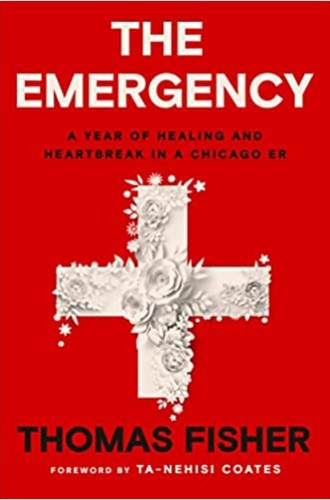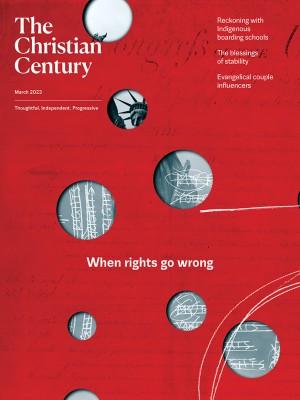A health-care system emergency
ER doctor Thomas Fisher writes with moral clarity—and a whiff of hopelessness.
Emergency room physician Thomas Fisher captures two common feelings in The Emergency. The first is the sense of panic and anxiety that began in March 2020 as many people in the United States waited for COVID-19 to reach us. The second is annoyance and frustration with our country’s health-care system, which many have experienced in ER lobbies while waiting for hours to be seen by a doctor.
Fisher chronicles his experiences working at the University of Chicago Medical Center during the COVID-19 pandemic against the backdrop of the racism that shapes not just his city but also the ER where he spends his days. A native South Sider, Fisher is impassioned about communicating clearly with his patients. This passion takes the form of letters to some of his patients, which are interspersed throughout the memoir. By examining segregation, capitalism, and social determinants of health, Fisher attempts to show his patients that they are not the ones who have failed. The problem is systemic: due to the very structure of our society, low-income people of color face worse health outcomes than others.
Read our latest issue or browse back issues.
Fisher sets the stage by portraying just how rapidly a shift in the ER unfolds for medical personnel, in stark contrast to the extended wait times patients often experience. “Sometimes the patients flow,” he writes. “Individuals turn into a blur of symptoms that need diagnosing, urgent problems that need fixing, impossible circumstances that need unraveling, and impediments to getting to the next patient.” Time usually permits ER doctors to spend only three minutes with each patient. In that time period, Fisher explains, he must evaluate the patient and determine a course of treatment. Those three minutes don’t allow him the time to truly see his patients, to unpack their experiences and answer their questions fully. Questions like, he writes, “How did this happen to me? Why am I suffering like this? How can I make it stop? And who, exactly, are you, this stranger standing so close, touching me, seeing me, this stranger I suddenly need?”
While he is constrained by time in the ER, this book offers Fisher the space to answer his patients’ most common questions—to explain how health-care inequities trickle down from macro-level political institutions like the Affordable Care Act, private insurance, Medicaid, and Medicare to meso-level factors like hospital policy to the individual patient at the micro level.
One letter he writes is to an 18-year-old, Nicole (a pseudonym), who was jumped and beaten up at school. “At eighteen this might be your first visit to the ER, but it’s not likely your last—everyone visits the ER at some point,” Fisher writes. “The ailments we treat uncover quirks in our society: like the way violence peaks on humid summer nights and how alcohol is involved in so many car collisions. The thousands who come to us every year reflect a society that stratifies and ranks.” He goes on to tell about the history of the ER. Before its advent, patients in need of emergency care would call their general practitioner to assess their issue. But many poor folks did not have access to a general practitioner, and many still don’t.
As Fisher recounts the development of the modern emergency department, he shares that he is a part of “the generation of doctors who came into the field to marry the treatment of physical, social, and societal emergencies.” Unfortunately, that hope was not grounded in the realities of emergency medicine. He writes to Nicole:
As I learned to identify patterns of hunger and homelessness, I’ve been frustrated by how few treatments we have to address these underlying issues. While medicine pushes the leading edge of twenty-first-century knowhow, social services dawdle in the nineteenth. This training is why I know that getting jumped at school, the way you were, isn’t just a matter of treating the physical injury. We can also screen for bullying and help you with interventions. But that day I didn’t take the time to dig into the second layer, beyond the injury, because I was distracted by the legions of people in the waiting room. I’m sorry.
Many of Fisher’s letters offer apologies alongside explanations to his patients. As I read, I felt myself empathizing with him, seeing how his job forces him to jump through the many hoops of the health-care system, preventing him from doing all he wishes he could do to help his patients. By the end of the book, however, I found myself irritated by his apologetic tone. While I gained a comprehensive look at how the health-care industry functions and how social factors such as race and class play into our medical care, I also experienced immense frustration at Fisher’s sense of hopelessness about health-care reform. While Fisher offers hope in his quest to do good, his words in a book written after the fact do little to help the patients who have already left his ER.
And perhaps this is the point. Perhaps his readers are supposed to feel the kind of deep frustration that inspires action. At the end of the book, Fisher calls for a moral transformation, stating that “everyone’s health would improve if we could reshape society toward the truth that everyone is equally human, but we cannot throw up our hands and simply wait until that radical awakening happens—lives are at stake.”
Health, Fisher demands, is a human right. It’s something that we owe one another. And without a radical overhaul of the current system, we will continue to see some people, like Fisher’s patients on the South Side of Chicago, treated as less than human. The Emergency is a serious and emotionally heavy memoir, but it is worth reading, especially for those who work outside of the health-care sector.






